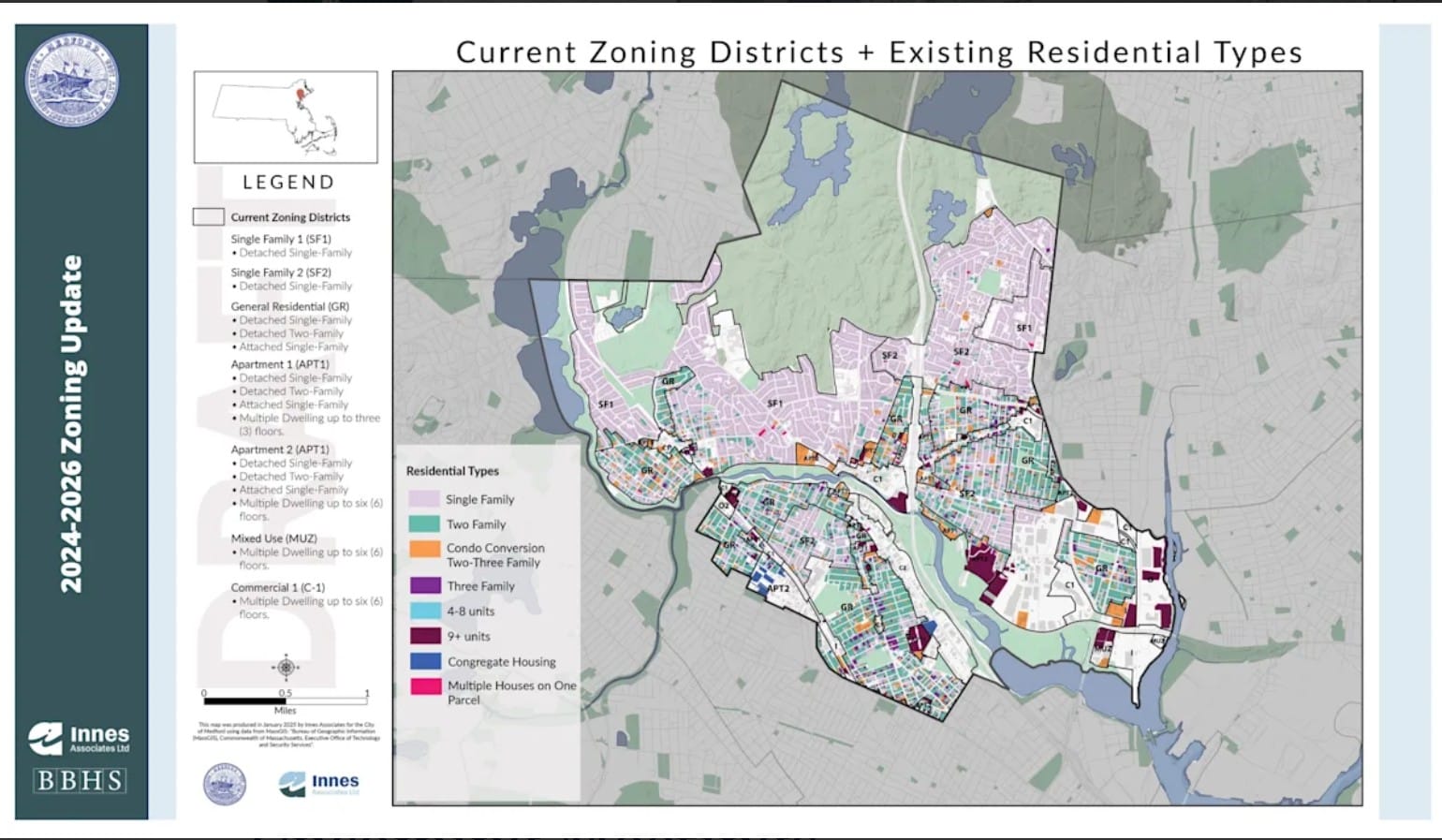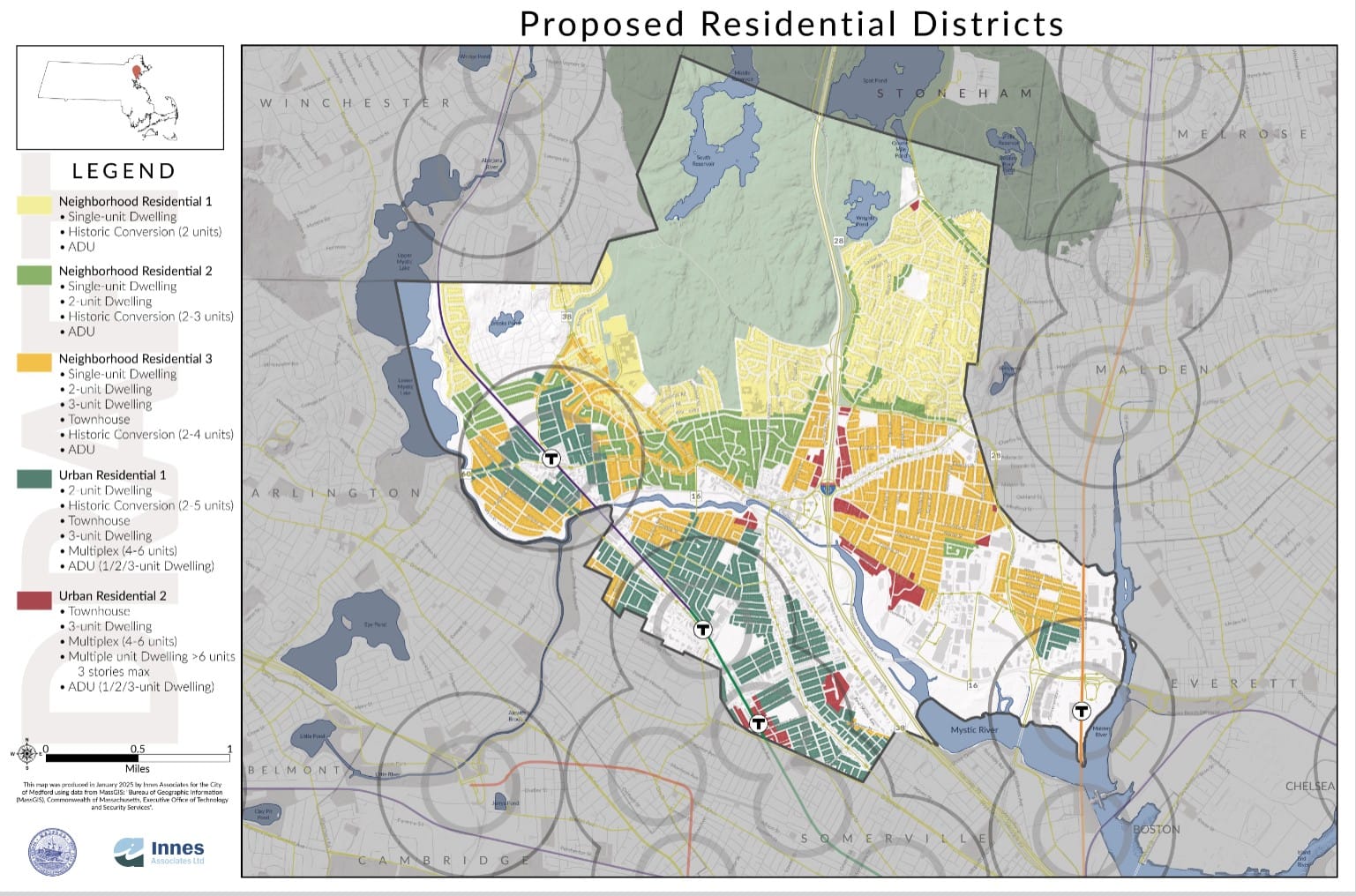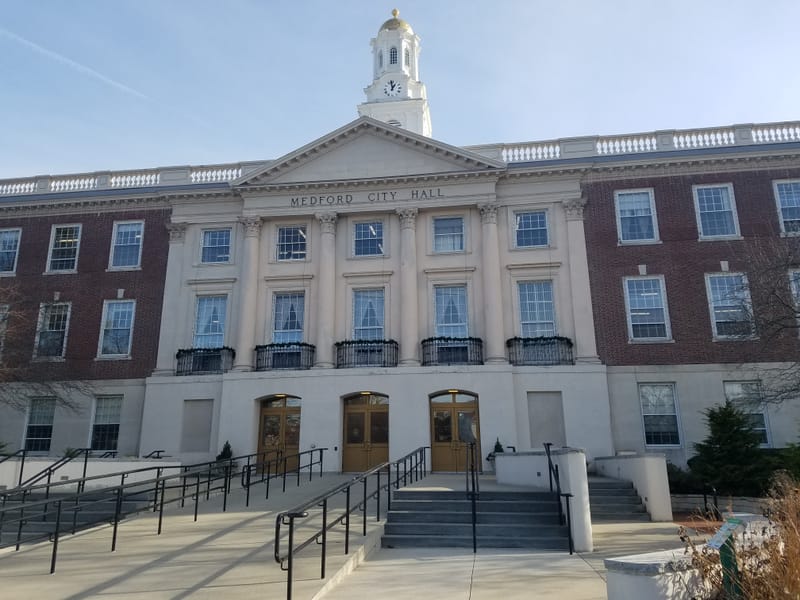Medford Community Development Board delays zoning vote for more public comment
This story has been updated: The deadline to submit a comment on the current iteration of the Residential Zoning Proposal is Wednesday, July 23.
By Neil Zolot
The Community Development Board (CBD) has decided to wait until October to vote on proposed changes in the zoning regulations for Neighborhood and Urban Residential (NR/UR) Districts and Accessory Dwelling Units (ADUs) and to solicit more public comment in the meantime.
“We’ve already gotten significant comment, but I’m hearing more outreach needs to be done,” said CDB head Emily Hedeman during a June 18 meeting, where she added the decision was based on testimony from dozens of residents during a City Council meeting. In addition to the residents who attended in-person, over 200 people tuned in via the Internet. “Public participation is good and we want to respect everybody’s feedback.”
Member Peter Calves agreed.
“It doesn’t make sense to vote on this tonight,” he said. “We want everyone to have a chance to speak. It’s a balance between people who have been with us and people who just came on.”
The board set a schedule of listening sessions, deliberations and voting over six Wednesdays from late June to early October:
• June 25: Discuss and possibly vote on provisions for the Squares, i.e. downtown and West Medford Square
• July 9: Last meeting for accepting verbal comment through testimony
• July 23: Deadline for written comment (Click here to submit a comment via the city's website.)
Hedeman said people who signed up to speak June 18, but weren’t able to because of time constraints will be given a chance to speak July 9.
• Aug. 6: Members will deliberate to provide direction to consultants Innes Associates.
• Sept. 9: Innes will come back with a report incorporating recommendations.
• Sept. 17: More deliberation by the board.
• Oct. 1: Vote by the board.
“Some comments contradict each other,” Planning, Development and Sustainability Director Alicia Hunt said. “We need to give the consultants direction in order to make changes.”
Based on a suggestion from consultant Emily Innes, the deliberative sessions will not include public comment.
Member Ben Lavallee called the timeline “reasonable.”
“If we’re going to set foundations that will affect the city for the next 30 years, I don’t see the benefit of rushing,” he said. “Let’s give ourselves more time rather than rush it to save a month. Ten years from now, no one will remember if it was in the summer or fall. They’ll remember if we got it right.”
Hedeman called the schedule “set until it isn’t.”
The presentation
Although they are separate, NR/UR Zoning and ADUs are intertwined and will be vetted together.
“I don’t see a world where we can decide ADUs without residential zoning,” Hunt said.
A presentation by Innes and Innes Associates urban planner Paula Ramos-Martinez outlined proposals to amend the zoning regulations for residential districts and ADUs. It included detailed provisions for dimensional standards, height, frontage, open space, permeable land and parking for lots with single family homes, duplexes and multi-family buildings of more than six units ranging from 4,000 to 8,000 square feet.
Most of the single family units are in South Medford, south and southwest of downtown along Winthrop Street towards Tufts University, Ball Square and Somerville. The 5,000-6,000-square-foot lots are more prevalent in West Medford near the Mystic Lakes towards Arlington. Lots up to 8,000 square feet are clustered along Winthrop Street/Route 38 as it runs towards Winchester.
Ramos-Martinez said the city has “quite a lot” of single family lots and “not a lot” of multi-unit town houses.
The idea is to codify regulations to make various existing buildings, proposed alterations, and new construction “by right” and not in need of a special permit.
What’s being discussed
Subdistricts are how the different areas of the city are categorized and organized under zoning. Each subdistrict has different rules for height, density, lot size, etc., that a development can have by-right.
Together with recent changes in state law, these new proposed subcategories, and their proposed distribution over Medford’s residential areas, represent changes for every neighborhood of the city.
Subdistricts set the “ceiling” for what may be developed on a given lot, but what is permitted to be built there in practice is impacted and constrained by requirements from both the state building code and Medford’s zoning code.
These other requirements include: open space minimums, lot coverage requirements, frontage and setback requirements, parking requirements, and other dimensional requirements and performance standards.
All projects proposed under new zoning would be subject to significant requirements in addition to minimum lot size and maximum number of units. These other requirements include dimensional requirements, performance standards, off-street parking requirements, affordable unit inclusionary zoning, Green Score (when applicable), and the building code.

These requirements mean that new projects on many lots will not contain the maximum number of principal and accessory housing units allowed in the proposed zoning district. The proposed Neighborhood Residential subdistricts reflect this requirement because they allow single-unit dwellings by-right.
Historic Conversion allows an existing structure that is a minimum of 70 years old and originally designed as one unit to be renovated to contain multiple units, with no change to the building’s exterior.
The goal of this mechanism is to allow for more small and diverse housing options, provide another mechanism for incrementally increasing density across the city, and ensure that development can occur while preserving and maintaining cultural heritage and historical character.
Currently, broad swathes of North and West Medford are zoned for single-family only, along with pockets in Glenwood, Hillside and Wellington; two-family dwellings are common throughout Haines Square, Glenwood, Hillside, South Medford, and some areas of West Medford.
Denser housing is concentrated in South Medford, Hillside, Medford Square, and near Tufts.
Nonconforming structures are scattered throughout all areas of the city. Five new subdistricts create a gradient, from lowest density to highest density.
What district goes where, and how much density is allowed, is guided by characteristics and context like existing uses, topography, public versus private ways, and access to transit.
For example, in North Medford, narrow winding streets, poor road condition, steep grades, and a preponderance of private ways (as opposed to public ways, which are roads owned and maintained by the city) affect what level of density and development is appropriate and possible.
Medford also has residential areas that are now next to new transit hubs, where greater density is both appropriate and needed, and areas where current zoning does not reflect the denser housing types that are already present.
These are areas of the city best suited to allow the higher levels of density to meet high housing demand and allow convenient transit access.
Residents react
Public comment on the zoning changes has been mixed. Here’s what residents had to say:
“We are ready, as a city, to take this step forward,” Nick Uhlig said. “Change isn’t easy, but resistance to change has its own cost. This will welcome new homeowners, new renters and new businesses over the next few years.”
“This is being proposed because we don’t offer enough housing,” Laura Punnett added. “Giving property owners an opportunity to redesign their properties is win-win because it offers more housing.”
“I hear a lot about empty storefronts,” Libby Brown said. “We need a critical mass of people who run errands on foot, and having units near mass transit is important.”
“I’m excited about added tax revenue,” Irene Ross said. “With higher density, there’ll be more businesses, which will allow us to collect more taxes. It will set Medford up to be successful.”
“I’m glad the city is finally doing this; a zoning overhaul is long overdue,” John Preusch added. “I want new zoning so people have the option to stay here and raise families.”
“I encourage you to move forward with this quickly,” Josh Manion, a municipal planner in Somerville, suggested.
Others disagreed.
“I took two days to digest this, but I still need more time,” Mike Corbett said. “What about developers coming into the city? Unless Medford is looking at this holistically, we won’t be ready for this.”
“I don't think this will do what a lot of people think it will in providing more housing,” Alexander Parcic added. “A developer will jump on this and people will have to spend more money for less space.”
“I don’t think the notification about this was very good,” Clare McGorrain said. “I just found out about this a few days ago and I’m fearful about what will happen. I don’t know how it will affect the value of my home.”
“I feel like West Medford is getting thrown in there, but not getting information,” Jim Doherty said. “We’re disproportionately affected and need more information as to what’s going on.”
“I do not feel we’ve done enough thinking about this,” Patricia Schiapelli said. “I feel adding more density will cause sewage backup. How much more can the police and fire departments handle? If the state can push back against the federal government on things they don’t want to do, the city can push back against the state. We need to fix what we have and then bring people in.”
“Let’s hear from the police, fire and public works departments and make the information public in plain language so people can understand things,” Page Buldini said. “Don’t rush this vote. Take the time to do the best we can.”
Jennifer Garon called implementation “too much too fast" and said "I support the revitalization of West Medford Square, but we need to consider the impact on our infrastructure, the burden on the police and fire departments and the impact on our schools.”
She also said the proposed changes do not address affordability.
“Density is coming and we need a plan for it, but the process is rushed,” Zachary Chertok said. “It’s disenfranchising people who are raising good questions.”
Board reactions
In discussion, member John Anderson acknowledged there’s no analysis as to what affect this will have on taxation and city services.
“There’s a lot of work to be done neighborhood-by-neighborhood,” he said. “Our neighborhoods are radically different. Each has its own issues and concerns.”
Lavallee also acknowledged “there’s a large number of people who said they just caught on.”
“I take the number of people just jumping on very seriously,” member Ari Fishman added. “Non-action is a risk, but the public has more to say.”
City Councilor Kit Collins did not attend or watch the meeting, but she told Gotta Know Medford, “Many people think with changes in zoning there’ll be changes on their block within five years, but that’s not going to happen. It expands what a property owner can do. It dictates what they can do; it’s about what’s allowable.”
She also said the general ethos is for a gradual drop off in density from urban into residential neighborhoods without down-zoning or deceasing density where it already exists.
“The principles reflect what we want to see, but also what’s on the ground to make existing buildings comply with zoning,” Collins explained.
NOTE: This story has been updated to correct a identification of a resident who spoke at the meeting.





